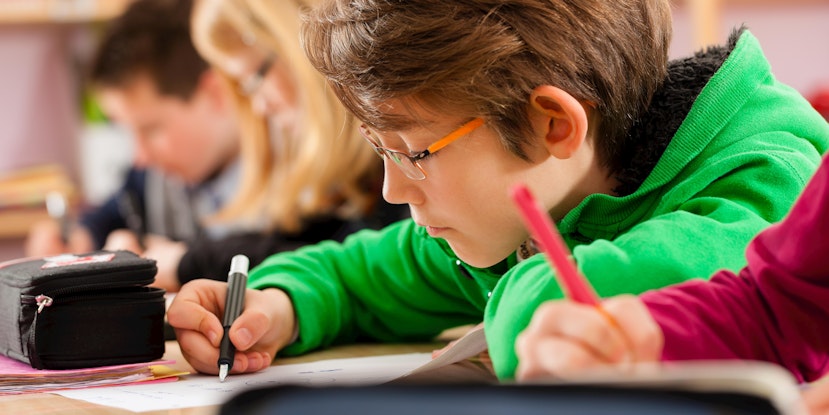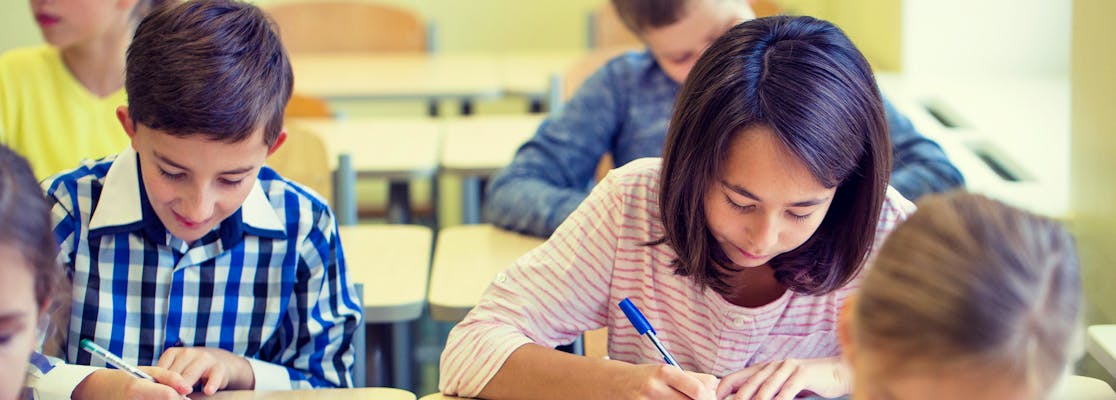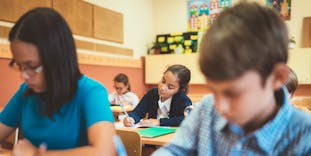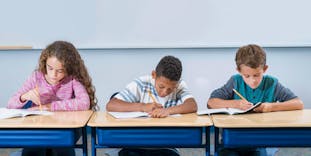How to Pass the 2nd Grade MAP Test in 2025
Updated November 6, 2024
The 2nd grade MAP test is designed to assess your child’s current academic level, their learning progress over time, and how they compare to their peers.
This online MAP test is regulated by the NWEA and is designed to help teachers identify your child’s strengths and weaknesses and predict their likely performance in future years.
Students may face the MAP test at the beginning of their 2nd grade school year, mid-way through, or at the end. Generally, the test will be taken at your child’s school.
Unlike many exams where all pupils face the same questions, the MAP test 2nd grade is adaptive to the individual child, presenting them with questions based on their responses.
A correct response, for instance, leads to more difficult questions, whereas an incorrect response is met with easier questions.
There are two types of 2nd grade MAP tests.
- MAP K-2 – For children who cannot yet read. In this version, written questions are replaced by recorded instructions that the child can listen to.
- MAP 2-5 – Taken by children who can read.
Free MAP Test Practice 2nd Grade & Analysis (2025)
The MAP test, also referred to as the ‘MAP Growth Assessment’, evaluates reading, language use and math across the entire age range from kindergarten to 12th grade.
The 2nd grade MAP test assesses these three subject areas at a level that is appropriate for most seven- to eight-year-olds.
In this section, we provide the opportunity to use a free NWEA practice test for 2nd grade. These sample questions are designed to give you a glimpse of the types of questions your child may encounter on the actual test.
Math Questions
The math questions will cover the following areas:
- Numbers and operations – For example, understanding fractions
- Geometry – For example, solving shape-related problems
- Operations and algebraic thinking – For example, analyzing patterns
- Measurement and data – For example, calculating geometric measurement
1. What digit is in the hundreds column of 974?
a) 7
b) 4
c) 9
d) 1
2. Which of the following shapes has four angles?
a) triangle
b) circle
c) square
d) pentagon
3. 49 + 3 = ?
a) 51
b) 52
c) 53
d) 54
4. In the following table, how many red lollipops were sold?
a) 9
b) 11
c) 10
d) 5
Language Use Questions
In this section, your child’s knowledge of grammar, spelling and vocabulary will be assessed.
In the MAP testing 2nd grade, the language use questions are divided into three distinct areas:
- Mechanics – For example, spelling
- Grammar and usage – For example, nouns and pronouns
- Writing process – For example, pre-planning
MAP Test Grade 2 - Language Use Sample Questions
1. Which of the following words is not spelled correctly?
a) lesson
b) scissers
c) teacher
d) paper
2. Which of the following verb pairs is wrong?
a) Do – did
b) Walk – walked
c) Sell – bought
d) Run – ran
3. Which words complete the sentence correctly?
My father folded his clothes into a ______.
a) chest and drawers
b) chest of drawers
c) chest and draws
d) chest of draw
4. Which contraction has the correctly placed apostrophe?
a) cant’
b) doesn’t
c) youv’e
d) lets’
Reading Questions
This section of the MAP test for 2nd graders is designed to assess your child’s understanding of written formats.
It also tests their ability to draw information from passages of text using their knowledge of linked themes, theories and concepts.
The reading questions in the 2nd grade MAP test can be split into three categories:
- Word meaning – For example, antonyms and synonyms
- Literary concepts – For example, characterization or genre
- Informational concepts – For example, conclusions or viewpoint
2nd Grade MAP Reading Test Practice Questions
1. What is the antonym of 'succeed'?
a) try
b) score
c) fail
d) achieve
2. Which of the following is alive?
a) rock
b) car
c) frog
d) computer
3. Read the passage.
Bobby liked to sit on the top of the climbing frame because from up there, she could see the roove of her house. She could also see the sky above and she liked to think that her mom and her little brother were looking up at the sky at that exact same time. It made her feel safer in the big, busy school she had recently moved to.
Which word is not spelled correctly?
a) climbing
b) roove
c) exact
d) busy
Understanding the 2nd Grade MAP Test Scores
MAP testing scores (2nd grade) are defined using the Rasch unIT scale (RIT).
At the end of the MAP test second grade, a numeric score on the RIT scale will be awarded for each of the three subject areas.

How to Prepare for 2th Grade MAP Test
Step 1. Review foundational skills
Focus on reinforcing key foundational skills in math and language arts.
This may include number sense, addition and subtraction, phonics, vocabulary and basic grammar.
Step 2. Practice reading regularly
Encourage daily reading to improve reading fluency, comprehension and vocabulary.
Read a variety of age-appropriate books, stories and informational texts.
Discuss the main idea, characters and events to enhance understanding.
Step 3. Enhance math skills
Practice basic math operations such as addition, subtraction, and simple multiplication and division.
Work on understanding patterns, time, money and basic measurement concepts.
Step 4. Utilize online resources
Explore online educational platforms, websites or apps that offer interactive games, exercises and practice materials specifically designed for 2nd Grade MAP Test preparation.
Step 5. Use sample questions
Look for sample questions or MAP practice tests for 2nd Grade.
These resources can help familiarize your child with the types of questions they may encounter and give them a sense of the test format.
Step 6. Create a study schedule
Develop a study schedule that includes regular practice sessions.
Break down the subjects and skills into manageable chunks, and allocate specific time for practicing math, reading and language arts.
Step 7. Work with your child's teacher
Collaborate with your child's teacher to understand the specific areas covered in the 2nd Grade MAP Test and seek guidance on how to support your child's preparation.
Teachers can provide valuable insights and resources tailored to your child's needs.
Step 8. Make learning fun
Incorporate hands-on activities, educational games and interactive approaches to make studying enjoyable for your child.
Use manipulatives, flashcards or educational apps to reinforce concepts.
Step 9. Encourage critical thinking
Help your child develop critical thinking and problem-solving skills.
Engage in discussions, ask open-ended questions and encourage your child to explain their reasoning and thought processes.
Step 10. Maintain a positive attitude
Foster a positive and supportive environment for your child's learning journey.
Encourage them, celebrate their progress and remind them that the MAP Test is an opportunity to showcase their skills and knowledge.
Tips to Ace the 2nd Grade MAP Test in 2025
The 2nd grade MAP test is designed to assess the academic levels of seven- to eight-year-olds. As with any school exam, the key to your child performing at their best in the test is preparation. There are plenty of ways that you can work with your child to help them prepare for the MAP test 2nd Grade.
Step 1. Use Practice Tests
One of the best ways that your child can prepare for any test is to become familiar with what they will face on the day, for instance, the format of the questions. This is where using a MAP practice test (2nd grade) can be helpful.
MAP NWEA practice tests 2nd grade can be sourced from the following provider:
As a parent, the main benefit to your child using practice papers is that you can see exactly what they will face and can help them accordingly.
Step 2. Work on Weak Areas in Their Knowledge
Once your child has begun to use practice papers and sample questions, it will become clear where their strengths and weaknesses lie. Continue to work with them on all learning topics but give your child extra help and practice in their weaker areas.
As your child uses more practice papers, track their improvement to ensure that they are making progress in their weaker subjects.
Step 3. Work With Your Child’s Teacher
You may think that you have a complete picture of your child’s educational progress, but what about the hours when your child is away from you at school? During that time, it is your child’s teacher who witnesses both the progress they make and the challenges they face. Take advantage of this by working with their teacher to support your child’s learning.
Ask their teacher where they feel that your child needs extra support and practice. Find out when the tests will take place and – with the teacher’s guidance – develop a home schedule for learning.
Starting and maintaining a conversation with your child’s teacher will provide you with a more rounded view of your child’s progress and flag up any areas of concern, whether academic or otherwise.
Step 4. Make Learning Fun
Sitting down to learn at home when a child has already spent their school day learning can lead to a resentful child who quickly loses focus. At seven or eight years old, they may also be tired by the end of the school day. Counter this by adding fun to the learning process.
Save practice papers for when your child is less likely to be tired, such as on the weekend. There are plenty of other ways you can help them learn that will seem less like lessons and more like fun.
Read books together that your child enjoys. That might mean you reading to them and then asking about what they have heard, or them reading to you.
Ask them to help you compile your weekly shopping list. They can write the shopping list, whether with paper and pen or using the note function on a mobile phone, while you tell them what to add. In addition to spending time with you, add an element of fun by asking them to add a treat for themselves.
Cooking together can combine lots of skills:
- Reading a recipe and food labels
- Pulling information from the recipe, such as what ingredients to add first
- Measuring ingredients or dividing cookie mixture into a set number of helpings
When you sit down to study with your child, remember to let them take regular breaks. This will help them to maintain focus, absorb information more easily and not build up a negative view of learning.
Finally, try not to put pressure on your children to learn. Find a way to make it a natural process at home, rather than an extension of school.
Step 5. Make Sure Your Child Is Healthy
It can be easy to forget that your child’s body is already doing a lot besides learning. It is growing and supporting your child’s progress. For it to do that well, it needs your support in making sure that your child is healthy.
They need sufficient sleep; for seven to eight years old that means 10 to 11 hours’ sleep most nights.
They need sufficient nutrition to support their developing bodies, including their brains. They will get this from a healthy, balanced diet that includes plenty of fruit and vegetables.
They need to stay hydrated; this is especially important for their brains to function at an optimal level. Make sure they drink plenty of water, instead of squash, soda or fruit juice.
Finally, make sure they are active. That does not have to be sports but getting out to play and run around is essential. Make it into a family event by going outdoors with them.
Prepare for 2nd Grade MAP Test with Test Prep Online
The 2nd Grade MAP test is a computerized test that your child can sit either at school or at home. The test examines a child’s cognitive abilities and what they have learned in school. It also determines what area they need to improve in before they sit another MAP test in the next grade.
The reading section of the MAP tests a child’s comprehension skills, vocabulary and writing skills.
Usually, students will have to sit between 40 and 43 questions, and it will take no longer than 60 minutes. This section may take the longest because of the time it will take for writing and reading.
If your child doesn't pass the MAP test in 2nd grade, it means they didn't do as well as expected in some subjects.
It shows areas where they may need more help or practice to catch up. It doesn't mean they're failing overall, but it points out areas where they can improve.
Teachers can use the test results to understand what your child needs help with and give them extra support in those areas.
It's a way to make sure your child gets the right help to do better in school.
A favorable MAP score for 2nd grade is typically within or above the average range (175-180 RIT). To understand scores better, consult with teachers or professionals, remembering that MAP assessments emphasize tracking growth over time.
You can use NWEA practice tests 2nd grade. These practice materials help you become familiar with the types of questions and the format of the test.
Pay attention in class, ask for help when needed, and practice reading and math skills regularly.
Use MAP test practice books, online resources or worksheets to reinforce your knowledge.
Work hard, stay positive, and remember that practice and effort can lead to improvement on the 2nd Grade MAP test.
Final Thoughts
The MAP test Grade 2 was designed to help teachers assist their pupils in making good educational progress. Help your child do their best in the actual test, and therefore succeed at school, by working with them to prepare for the test.
Learning is not only an in-school process; it also has a place in the home. With the right attitude, it can turn into a fun, family routine.



